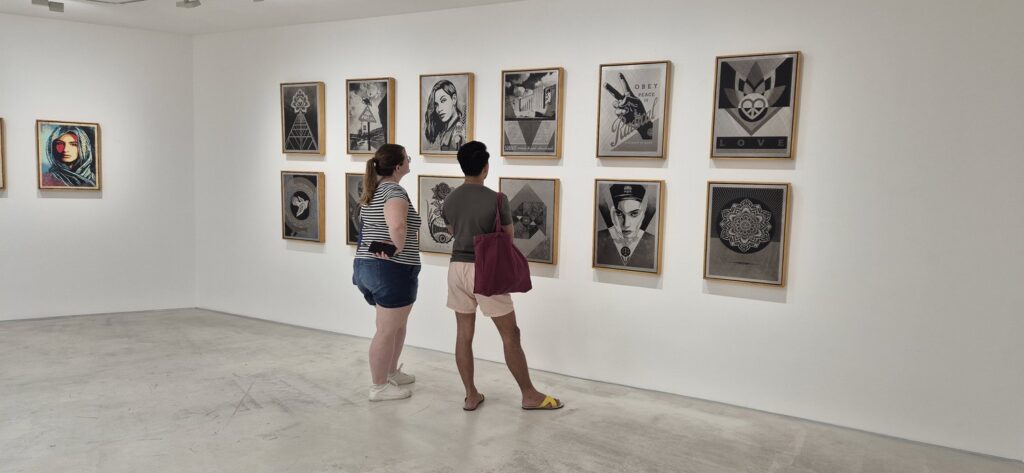
As a Bangkokian with a deep pastime for artwork, there’s at all times a specific thrill when the world over acclaimed artists make a selection our town as a platform for his or her paintings. Through the years, Bangkok has welcomed an important roster of world ability, but few have captivated audiences by means of seamlessly weaving in combination this kind of various array of mediums, ocular storytelling, and potent political remark relatively like Shepard Fairey.Fairey’s untouched exhibition, Yellowish Compass, now on show at Over The Influence Bangkok, is extra than simply an artwork show off—it’s an impressive commentary that injects a refreshing jolt of side road credibility and provocative political discourse into our town’s thriving however on occasion wary artwork scene. Via daring mixed-media artwork, intricate stencil works, and his signature display screen prints, Shepard Fairey invitations Bangkokians to discover deep topics of social justice, activism, and private mirrored image.Era visiting Bangkok to creation this compelling assortment, Shepard generously took the week to take a seat ailing and percentage insights into his inventive procedure, inspirations, and the duty he feels as an artist in as of late’s charged cultural order.Your “Andre the Giant Has a Posse” decal marketing campaign began as a tiny side road artwork experiment however grew into a world phenomenon. While you had your first exhibition, how did it really feel to transition from the streets to the gallery areas? Did that shift exchange the way you considered your personal paintings?
Shepard Fairey: In contrast to some side road artists with out formal artwork coaching, I attended the Rhode Island School of Design, the place I studied representation and printmaking but additionally concerned about resolved standalone artwork items that may be exhibited in a gallery. Once I started with side road artwork, I meant in order artwork to crowd in community areas, however I at all times viewed making nice artwork as a logical step in my artwork observe, connecting the worlds the place crowd had been uncovered to artwork haphazardly and the worlds the place crowd deliberately sought out artwork. In alternative phrases, operating each within the streets and the galleries was once a logical evolution, regardless that I needed to believe each the variations in want contextually and the techniques through which the works may just relate to every alternative.
A lot of your artwork, from the OBEY marketing campaign to the Hope poster, demanding situations authority and provokes idea. In as of late’s hastily transferring political and cultural parks, do you spot side road artwork and activism turning into much more crucial? How do you assume artists must reply to international crises thru their paintings?
SF: I feel side road artwork and political artwork are extra crucial as a result of we’re all now inundated with extra imagery than ever on-line, which doesn’t essentially remind us of the want to have interaction with real-world issues in real-world areas. My hope is that side road artwork and political artwork no longer most effective catalyze deeper research of diverse social and political dynamics but additionally remind crowd that being outspoken and taking motion is a very powerful to impacting the actual global.
You’ve exhibited around the globe. Have you ever spotted variations in how audiences within the East as opposed to the West interpret your politically charged art work? Do cultural views shift the which means of your paintings in ways in which miracle you?
SF: There are at all times fascinating variations in cultural standpoint from park to park, however I’ve additionally discovered consistency in positive ideas of human psychology reassuring. Once I confirmed in Moscow, a park that suppresses political dissent, I used to be moved by means of the ambitious reaction to a lot of my works wondering authority, although the ones target audience participants didn’t have the similar standpoint on political dissent. Asia isn’t a monolith, however basically, I’ve discovered Asian tradition to be extra well mannered, so it’s been interesting to talk about my methods for critiquing social and political problems in parks the place rocking the boat can also be frowned upon. My methods area from being loudly opposed to a lot more mischievous, seductive, and aspirational. Relying on the place I’m, I would possibly incline in a single path or the alternative, however this area of approaches will likely be perceptible in any display I do globally.
Your artwork blends side road aesthetics with tactics like display screen printing and large-scale work of art, ceaselessly incorporating daring propaganda-style imagery. What drew you to this mix of mediums, and the way do you spot them operating in combination to magnify your message?
SF: The mediums I utility are dictated by means of a couple of variables, together with what’s maximum tough aesthetically, what’s sensible technically, and what conveys my message in a direct and relatable means. My diverse inspirations fuse with my philosophical and sensible considerations, handover my genre and the mix of tactics I make a selection. It’s a for much longer dialogue, however there’s a well-considered rationale for each and every travel I assemble.
From punk rock book covers to Soviet-era propaganda influences, your paintings has at all times drawn from a various area of ocular types. Was once there a selected era or affect—possibly a band, a motion, or a coach—that made you know artwork generally is a tough software for social exchange?
SF: Skateboarding and punk rock had been life-changing for me. Each are rebellious cultures with distinct ocular types, however punk rock, particularly on account of its social and political remark, opened my perceptible to the probabilities of creativity and social remark in an impressive and relaxing means. Many ocular artists, together with Robbie Conal, Barbara Kruger, and Robert Rauschenberg, have impressed me. So far as merging side road and gallery aesthetics, the graffiti artist Barry McGee, AKA Twist was once a plethora affect.

